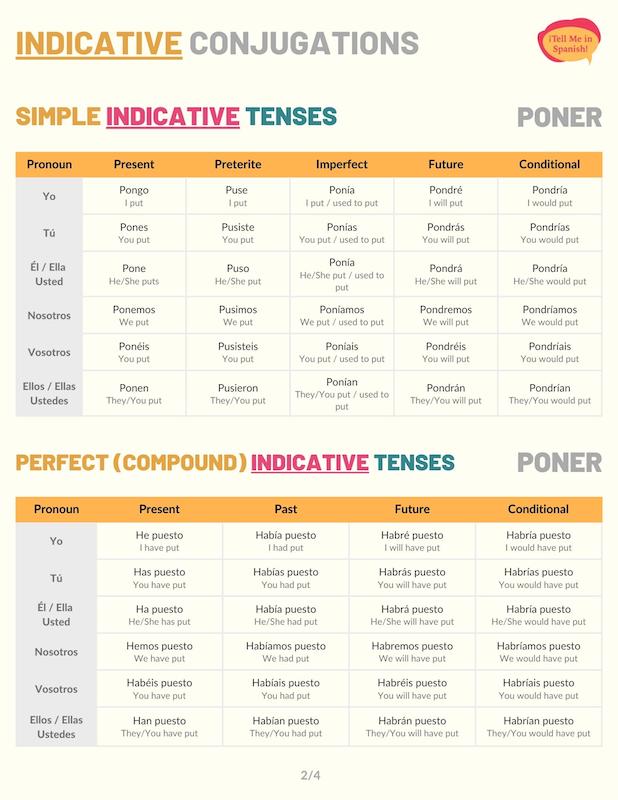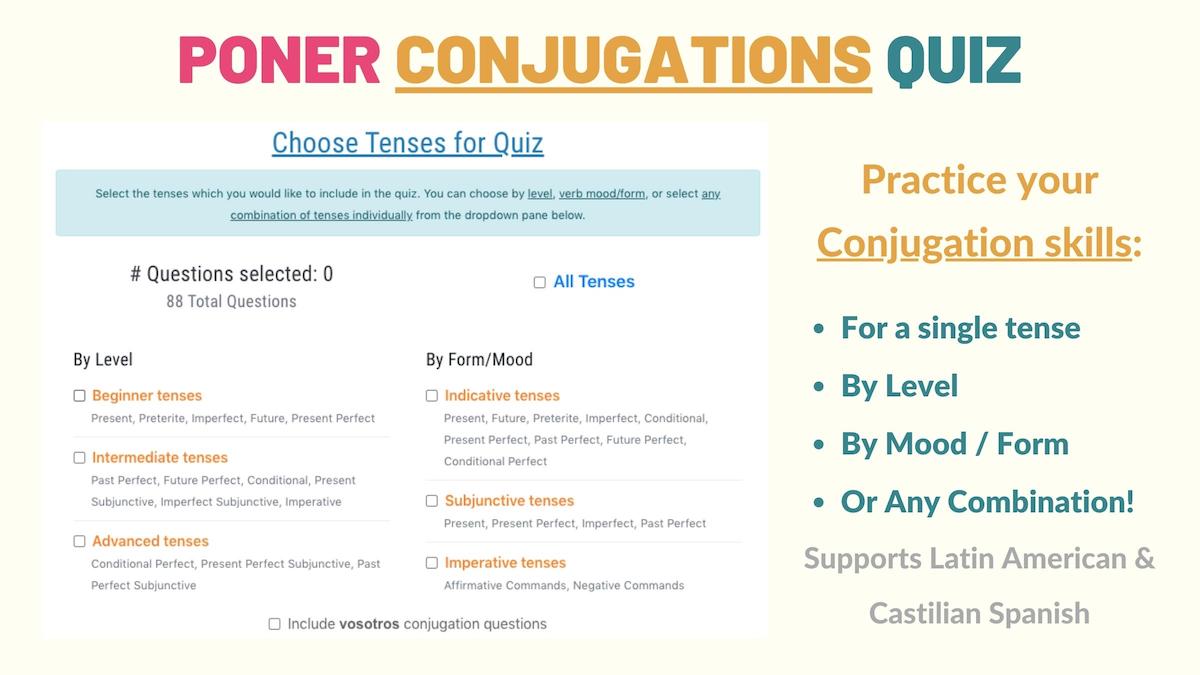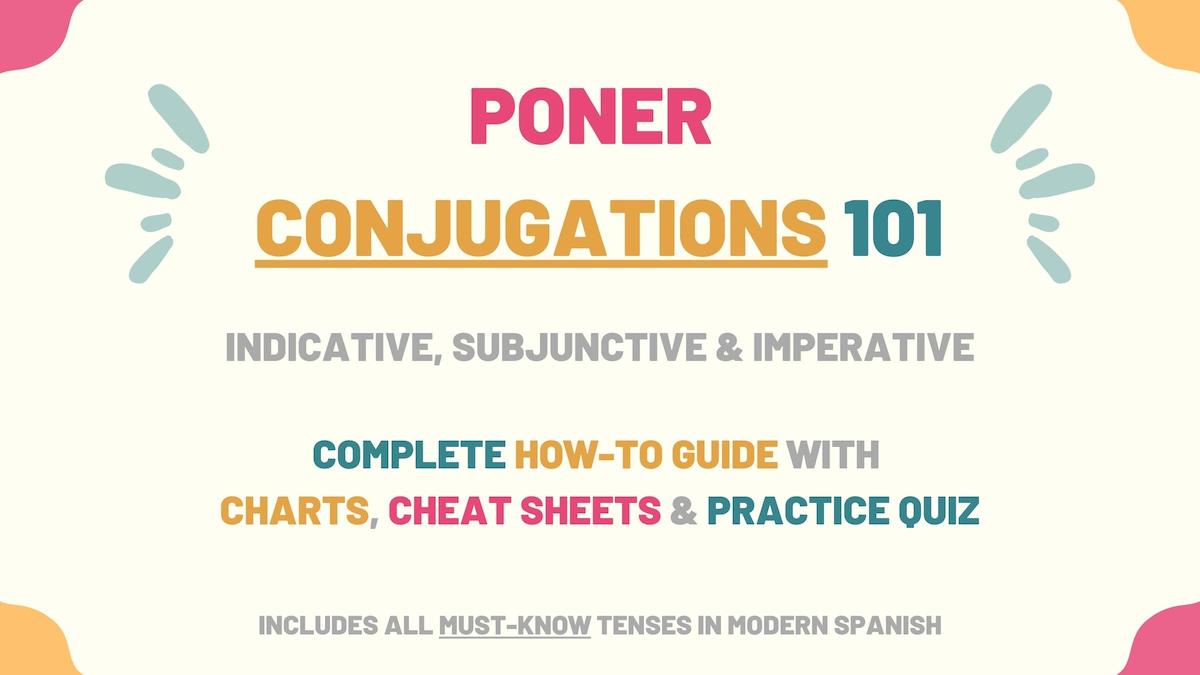Poner is a common irregular verb in Spanish. But, despite its irregularities, this is a verb we use in daily conversations. As a result, in this guide, we’ll check the most common poner conjugation charts. Here’s an overview of what we’ll learn:
- Poner Overview
- Indicative Tenses of Poner Conjugations
- Subjunctive Tenses of Poner Conjugations
- Imperative (Commands) of Poner Conjugations
- Uses & Examples
- Download Poner Conjugation Tables & Uses Cheat sheets
- Poner Conjugation Practice Quiz
Overview of Poner
| Verb Characteristic | Property |
|---|---|
| Verb Type | -ER |
| Irregular | Yes |
| Infinitive | Poner |
| Gerund (Present Participle) Form | Poniendo |
| Past Participle Form | Puesto |
| Synonyms | Colocar, vestirse, situar, empezar. |
Irregularities:
- Present Indicative: pong only ‘yo’.
- Preterite: pus for all subject pronouns.
- Future & Conditional: pondr for all subject pronouns.
- Present Subjunctive: pong for all subject pronouns.
- Imperfect Subjunctive: pusie for all subject pronouns.
- Affirmative Imperative: pon for ‘tú’, pong for ‘usted’ and ‘ustedes’.
- Negative Imperative: pong for all subject pronouns.
In Spanish, poner means ‘to put’, ‘to add’, ‘to put on’, among other applications. The conjugation charts below only have one translation to keep the tables as organized as possible. You can learn more about the meanings of ‘poner’ in the section Uses & Meanings.
Indicative Conjugations of Poner
Present tense
Poner conjugations in the present tense are all regular, except for the form yo. With this subject pronoun, we must use the stem pong. Conjugate poner to the present indicative tense to communicate that people are currently putting, dressing, or placing something.
For example: ¿Qué le pongo a la sopa?
| Person | Conjugation | Translation |
|---|---|---|
| Yo | Pongo | I put |
| Tú | Pones | You put |
| Él / Ella Usted | Pone | He/She puts You (formal) put |
| Nosotros | Ponemos | We put |
| Vosotros | Ponéis | You put |
| Ellos / Ellas Ustedes | Ponen | They put You (plural) put |
Preterite tense
Poner preterite conjugations are irregular. Use the stem pus for all subject pronouns and omit the accent marks in the preterite tense endings. In this tense, ‘poner’ refers to the things people put or placed in the past. For instance: Niños, ¿dónde pusieron el control?
| Person | Conjugation | Translation |
|---|---|---|
| Yo | Puse | I put |
| Tú | Pusiste | You put |
| Él / Ella Usted | Puso | He/She put You (formal) put |
| Nosotros | Pusimos | We put |
| Vosotros | Pusisteis | You put |
| Ellos / Ellas Ustedes | Pusieron | They put You (plural) put |
Imperfect tense
When conjugated to the indicative imperfect tense, poner is a regular verb. Use the imperfect conjugations to explain where people used to put things repeatedly in the past. For instance: Mi mamá siempre ponía música cuando cocinaba.
| Person | Conjugation | Translation |
|---|---|---|
| Yo | Ponía | I put I used to put |
| Tú | Ponías | You put You used to put |
| Él / Ella Usted | Ponía | He/She put He/She used to put You (formal) put You (formal) used to put |
| Nosotros | Poníamos | We put We used to put |
| Vosotros | Poníais | You put You used to put |
| Ellos / Ellas Ustedes | Ponían | They put They used to put You (plural) put You (plural) used to put |
Near future
Poner conjugated to the immediate or near future tense communicates that a person will put something somewhere soon in the future. We use the formula ir (present tense) + a + poner to form this tense. For example: Espérame, voy a ponerle sal a la sopa.
| Person | Conjugation | Translation |
|---|---|---|
| Yo | Voy a poner | I’m going to put |
| Tú | Vas a poner | You’re going to put |
| Él / Ella Usted | Va a poner | He/She is going to put You (formal) are going to put |
| Nosotros | Vamos a poner | We’re going to put |
| Vosotros | Vais a poner | You’re going to put |
| Ellos / Ellas Ustedes | Van a poner | They’re going to put You (plural) are going to put |
Future simple tense
Poner future tense conjugations are irregular, and we form them with the stem pondr. Conjugate this verb to the future simple to explain that people will put something somewhere or wear certain clothes at some point in the future. Mañana me pondré el vestido rojo.
| Person | Conjugation | Translation |
|---|---|---|
| Yo | Pondré | I will put |
| Tú | Pondrás | You will put |
| Él / Ella Usted | Pondrá | He/She will put You (formal) will put |
| Nosotros | Pondremos | We will put |
| Vosotros | Pondréis | You (formal) will put |
| Ellos / Ellas Ustedes | Pondrán | They will put You (plural) will put |
Conditional tense
The Spanish conditional forms of poner are also formed with the irregular stem pondr. Use these conjugations to talk about what people would wear or put somewhere. Creo que mi mamá no pondría las flores en esa mesa.
| Person | Conjugation | Translation |
|---|---|---|
| Yo | Pondría | I would put |
| Tú | Pondrías | You would put |
| Él / Ella Usted | Pondría | He/She would put You (formal) would put |
| Nosotros | Pondríamos | We would put |
| Vosotros | Pondríais | You would put |
| Ellos / Ellas Ustedes | Pondrían | They would put You (plural) would put |
Present perfect tense
The Spanish present perfect tense is formed with haber in the present tense + puesto (past participle). Conjugate this verb to the present perfect tense to discuss what people have or haven’t put somewhere. For instance: ¿Por qué no han puesto la comida en el refrigerador?
| Person | Conjugation | Translation |
|---|---|---|
| Yo | He puesto | I have put |
| Tú | Has puesto | You have put |
| Él / Ella Usted | Ha puesto | He/She has put You (formal) have put |
| Nosotros | Hemos puesto | We have put |
| Vosotros | Habéis puesto | You have put |
| Ellos / Ellas Ustedes | Han puesto | They have put You (plural) have put |
Take Note: Poner is one of the few verbs with an irregular past participle in Spanish.
Past perfect
Conjugate poner to the Spanish past perfect tense to express that someone had or hadn’t put something before another reference point in the past. For instance: Cuando llegué, mis papás ya habían puesto la película.
To form the past perfect, use the imperfect form of ‘haber’ and the past participle form of ‘poner’.
| Person | Conjugation | Translation |
|---|---|---|
| Yo | Había puesto | I had put |
| Tú | Habías puesto | You had put |
| Él / Ella Usted | Había puesto | He/She had put You (formal) had put |
| Nosotros | Habíamos puesto | We had put |
| Vosotros | Habíais puesto | You had put |
| Ellos / Ellas Ustedes | Habían puesto | They had put You (plural) had put |
Future perfect
Poner conjugated to the Spanish future perfect conveys that someone will have put something somewhere by or before a certain moment in the future. We also use these forms to talk about what someone might put. For example: En unas horas, habré puesto todo en su lugar.
| Person | Conjugation | Translation |
|---|---|---|
| Yo | Habré puesto | I will have put |
| Tú | Habrás puesto | You will have put |
| Él / Ella Usted | Habrá puesto | He/She will have put You (formal) will have put |
| Nosotros | Habremos puesto | We will have put |
| Vosotros | Habréis puesto | You will have put |
| Ellos / Ellas Ustedes | Habrán puesto | They will have put You (plural) will have put |
Conditional perfect
In Spanish, conjugate poner to the conditional perfect for expressing that someone would have put something somewhere if a past action had been completed. For instance: Si nos hubieras dicho, habríamos puesto tus cosas en el carro.
| Person | Conjugation | Translation |
|---|---|---|
| Yo | Habría puesto | I would have put |
| Tú | Habrías puesto | You would have put |
| Él / Ella Usted | Habría puesto | He/She would have put You (formal) would have put |
| Nosotros | Habríamos puesto | We would have put |
| Vosotros | Habríais puesto | You would have put |
| Ellos / Ellas Ustedes | Habrían puesto | They would have put You (plural) would have put |
Progressive tenses
The progressive tenses of poner convey that someone is putting something at the moment of speaking. Use estar conjugated + present participle (poniendo) to form these tenses. Here is a sentence: Creo que le están poniendo mucha sal a la comida.
| Progressive Tense | Formula | Translation Example |
|---|---|---|
| Present | Estar (present) + poniendo | I am putting |
| Preterite | Estar (preterite) + poniendo | You were putting |
| Imperfect | Estar (imperfect) + poniendo | He was putting |
| Future | Estar (future) + poniendo | We will be putting |
| Conditional | Estar (conditional) + poniendo | They would be putting |
Poner Subjunctive Conjugations
The subjunctive mood in Spanish conveys uncertainty, wishes, suggestions, requests, and expectations and also refers to hypothetical situations. In the sections below, you’ll find all of the poner conjugation charts for these tenses.
Present subjunctive
Poner subjunctive conjugations are irregular. To conjugate to this tense, we must use the stem pong for all subject pronouns. Use ‘poner’ in the present subjunctive to wish or request that someone puts something in a certain place.
For instance: La maestra quiere que pongamos sus libros en la mesa.
| Person | Conjugation | Translation |
|---|---|---|
| Yo | Ponga | I put |
| Tú | Pongas | You put |
| Él / Ella Usted | Ponga | He/She puts You (formal) put |
| Nosotros | Pongamos | We put |
| Vosotros | Pongáis | You put |
| Ellos / Ellas Ustedes | Pongan | They put You (plural) put |
Present perfect subjunctive
To conjugate poner to the present perfect subjunctive use haber in the present subjunctive + puesto. Use these conjugations to wonder or wish someone has already put something somewhere. ¿Quién crees que haya puesto este letrero?
| Person | Conjugation | Translation |
|---|---|---|
| Yo | Haya puesto | I have put |
| Tú | Hayas puesto | You have put |
| Él / Ella Usted | Haya puesto | He/She has put You (formal) have put |
| Nosotros | Hayamos puesto | We have put |
| Vosotros | Hayáis puesto | You have put |
| Ellos / Ellas Ustedes | Hayan puesto | They have put You (plural) have put |
Imperfect subjunctive
The Spanish imperfect subjunctive conjugations of ‘poner’ are used to communicate past suggestions, requests, wishes, or expectations you had about someone putting something somewhere. Use the stem pusie to form this tense. Les dije que no pusieran mi ropa en el sol.
Depending on the type of Spanish you use, there are two conjugation models for the imperfect subjunctive tense:
Latin American Spanish version
| Person | Conjugation | Translation |
|---|---|---|
| Yo | Pusiera | I put |
| Tú | Pusieras | You put |
| Él / Ella Usted | Pusiera | He/She put You (formal) put |
| Nosotros | Pusiéramos | We put |
| Ellos / Ellas Ustedes | Pusieran | They put You (plural) put |
Note: Because Latin American Spanish doesn’t use the pronoun ‘vosotros’, the poner conjugation for ‘vosotros’ has been omitted in the conjugation chart above.
Castilian Spanish version
| Person | Conjugation | Translation |
|---|---|---|
| Yo | Pusiese | I put |
| Tú | Pusieses | You put |
| Él / Ella Usted | Pusiese | He/She put You (formal) put |
| Nosotros | Pusiésemos | We put |
| Vosotros | Pusieseis | You put |
| Ellos / Ellas Ustedes | Pusiesen | They put You (plural) put |
Past perfect subjunctive
Poner conjugated to past perfect subjunctive expresses that someone would have placed something somewhere if a past condition was completed. These forms can also express regret or hypothetical results if someone had put or wore something.
For example: Si hubiera puesto atención, no habría reprobado.
| Person | Conjugation | Translation |
|---|---|---|
| Yo | Hubiera puesto | I had put |
| Tú | Hubieras puesto | You had put |
| Él / Ella Usted | Hubiera puesto | He/She had put You (formal) had put |
| Nosotros | Hubiéramos puesto | We had put |
| Vosotros | Hubierais puesto | You had put |
| Ellos / Ellas Ustedes | Hubieran puesto | They had put You (plural) had put |
Take Note: Poner atención is a common expression with poner, and it means ‘to pay attention’.
Poner Imperative Conjugations
Spanish commands are formed with the imperative mood. We use these conjugations to order people to do something.
Affirmative commands
Poner affirmative commands conjugations are irregular except for ‘vosotros’. Informal commands (tú) are formed with the stem pon while formal and plural imperatives use the stem pong. In the affirmative imperative, this verb is used to order people to put something on or somewhere.
For instance: Pongan la comida en el refrigerador.
| Person | Conjugation | Translation |
|---|---|---|
| Tú | Pon | Put |
| Usted | Ponga | Put |
| Vosotros | Poned | Put |
| Ustedes | Pongan | Put |
Negative commands
The negative commands of poner use the same conjugations as the present subjunctive. We use these forms of ‘poner’ to order someone not to put something on or somewhere. For example: ¡No pongas esa película, no me gusta!
| Person | Conjugation | Translation |
|---|---|---|
| Tú | No pongas | Don’t put |
| Usted | No ponga | Don’t put |
| Vosotros | No pongáis | Don’t put |
| Ustedes | No pongan | Don’t put |
Meanings of Poner & Examples
Now that you’ve learned how to conjugate poner in Spanish, you should see the following examples of how to use this verb. In its non-reflexive form, poner means to:
- Put, add or to place
- Give (when talking about grades)
- Put something on (on someone else)
- Fill in or put down
- Lay eggs
- Open (businesses or stores)
[Poner conjugated] + [complement]
Ponle los calcetines al bebé.
Put the socks on the baby.
Mis hermanos pondrán un restaurante.
My brothers will open a restaurant.
¿Por qué le pusiste tanto ajo a la comida?
Why did you put so much garlic in the food?
Take Note: When talking about putting something on someone or somewhere, poner works with direct and indirect object pronouns. Be aware that the placement of these pronouns will vary depending on the verb conjugation.
The reflexive form ponerse means ‘to put on (oneself)’ or ‘to start doing something’. You must use reflexive pronouns to keep these meanings:
[Reflexive pronoun] + [poner conjugated] + a + infinitive verb
¿Por qué te pusiste mi vestido?
Why did you put my dress on?
Me voy a poner a buscar departamento.
I am going to start looking for an apartment.
Take Note: Ponerse uses the same conjugation as ‘poner’. The only difference is that you need to use reflexive pronouns.
Download Poner Conjugation Tables & Uses Cheat sheets

Poner is a highly irregular Spanish -ER verb. So, it can be difficult to learn and memorize all its different forms in the various key tenses. It’s also a highly dynamic verb with multiple meanings which are dependent based on the context. So, I’ve created a downloadable PDF containing all of the poner conjugation charts as well as its meanings and uses along with example sentences which apply to daily conversational Spanish.
Practice Quiz: Poner Conjugation

Now that you know how to conjugate poner, you might want to drill your Spanish verb skills. Feel free to take the poner conjugation practice quiz to test your knowledge with the many irregularities this verb has in different tenses.



